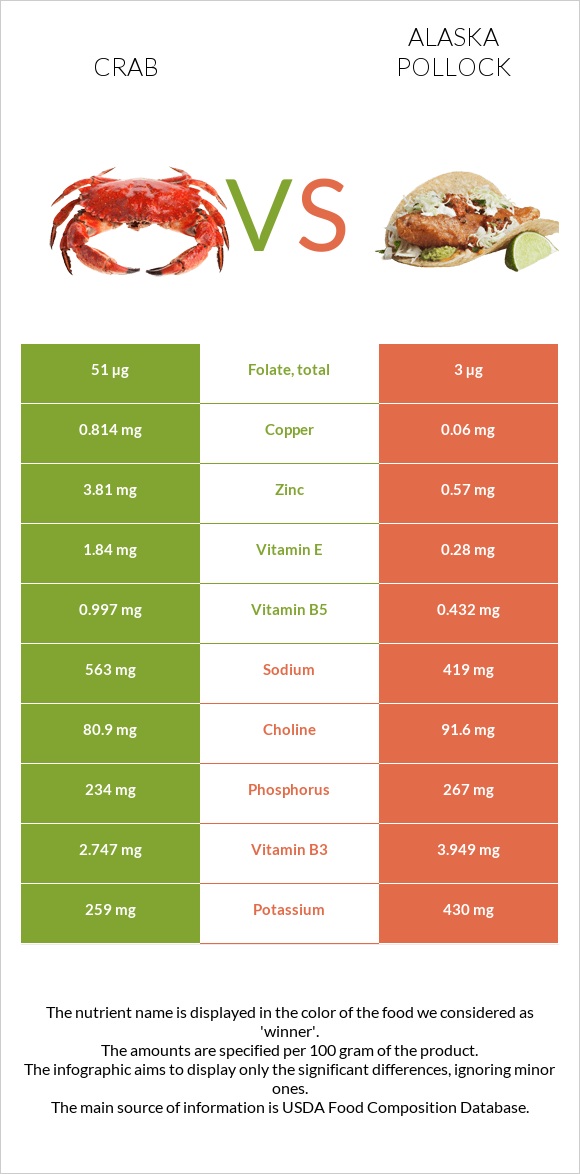Crab vs. Pollock — In-Depth Nutrition Comparison
Compare
How are crab and pollock different?
- Crab is richer in copper, zinc, folate, vitamin B5, and vitamin E, while pollock is higher in vitamin B12, vitamin B6, magnesium, vitamin B2, and vitamin D.
- Crab covers your daily need for copper, 84% more than pollock.
- Crab contains 17 times more folate than pollock. Crab contains 51µg of folate, while pollock contains 3µg.
Crustaceans, crab, blue, canned and Fish, pollock, Alaska, cooked, dry heat (may have been previously frozen) types were used in this article.
Infographic

Infographic link
Mineral Comparison
Mineral comparison score is based on the number of minerals by which one or the other food is richer. The "coverage" charts below show how much of the daily needs can be covered by 300 grams of the food.
| Contains more CalciumCalcium | +26.4% |
| Contains more CopperCopper | +1256.7% |
| Contains more ZincZinc | +568.4% |
| Contains more ManganeseManganese | +311.1% |
| Contains more MagnesiumMagnesium | +125% |
| Contains more PotassiumPotassium | +66% |
| Contains more IronIron | +12% |
| Contains more PhosphorusPhosphorus | +14.1% |
| Contains less SodiumSodium | -25.6% |
Vitamin Comparison
Vitamin comparison score is based on the number of vitamins by which one or the other food is richer. The "coverage" charts below show how much of the daily needs can be covered by 300 grams of the food.
| Contains more Vitamin CVitamin C | +∞% |
| Contains more Vitamin EVitamin E | +557.1% |
| Contains more Vitamin B5Vitamin B5 | +130.8% |
| Contains more Vitamin KVitamin K | +200% |
| Contains more FolateFolate | +1600% |
| Contains more Vitamin AVitamin A | +1600% |
| Contains more Vitamin DVitamin D | +∞% |
| Contains more Vitamin B1Vitamin B1 | +134.8% |
| Contains more Vitamin B2Vitamin B2 | +139.8% |
| Contains more Vitamin B3Vitamin B3 | +43.8% |
| Contains more Vitamin B6Vitamin B6 | +110.9% |
All nutrients comparison - raw data values
| Nutrient |  |
 |
DV% diff. |
| Copper | 0.814mg | 0.06mg | 84% |
| Zinc | 3.81mg | 0.57mg | 29% |
| Vitamin B12 | 3.33µg | 3.66µg | 14% |
| Vitamin B6 | 0.156mg | 0.329mg | 13% |
| Folate | 51µg | 3µg | 12% |
| Protein | 17.88g | 23.48g | 11% |
| Magnesium | 36mg | 81mg | 11% |
| Vitamin B5 | 0.997mg | 0.432mg | 11% |
| Vitamin E | 1.84mg | 0.28mg | 10% |
| Vitamin B2 | 0.093mg | 0.223mg | 10% |
| Vitamin B3 | 2.747mg | 3.949mg | 8% |
| Vitamin D | 0µg | 1.3µg | 7% |
| Vitamin D | 0 IU | 51 IU | 6% |
| Sodium | 563mg | 419mg | 6% |
| Potassium | 259mg | 430mg | 5% |
| Phosphorus | 234mg | 267mg | 5% |
| Vitamin C | 3.3mg | 0mg | 4% |
| Cholesterol | 97mg | 86mg | 4% |
| Vitamin B1 | 0.023mg | 0.054mg | 3% |
| Calcium | 91mg | 72mg | 2% |
| Vitamin A | 1µg | 17µg | 2% |
| Manganese | 0.074mg | 0.018mg | 2% |
| Selenium | 42.9µg | 44.1µg | 2% |
| Choline | 80.9mg | 91.6mg | 2% |
| Polyunsaturated fat | 0.258g | 0.583g | 2% |
| Calories | 83kcal | 111kcal | 1% |
| Fats | 0.74g | 1.18g | 1% |
| Iron | 0.5mg | 0.56mg | 1% |
| Vitamin K | 0.3µg | 0.1µg | 0% |
| Trans fat | 0.014g | N/A | |
| Saturated fat | 0.201g | 0.159g | 0% |
| Monounsaturated fat | 0.129g | 0.134g | 0% |
| Tryptophan | 0.226mg | 0.263mg | 0% |
| Threonine | 0.727mg | 1.029mg | 0% |
| Isoleucine | 0.776mg | 1.082mg | 0% |
| Leucine | 1.307mg | 1.908mg | 0% |
| Lysine | 1.386mg | 2.157mg | 0% |
| Methionine | 0.452mg | 0.696mg | 0% |
| Phenylalanine | 0.708mg | 0.917mg | 0% |
| Valine | 0.806mg | 1.21mg | 0% |
| Histidine | 0.393mg | 0.691mg | 0% |
| Omega-3 - EPA | 0.101g | 0.086g | N/A |
| Omega-3 - DHA | 0.067g | 0.423g | N/A |
| Omega-3 - DPA | 0.009g | 0.027g | N/A |
| Omega-6 - Eicosadienoic acid | 0.005g | N/A |
Macronutrient Comparison
Macronutrient breakdown side-by-side comparison
| Contains more ProteinProtein | +31.3% |
| Contains more FatsFats | +59.5% |
~equal in
Carbs
~0g
~equal in
Water
~73.65g
~equal in
Other
~1.69g
Fat Type Comparison
Fat type breakdown side-by-side comparison
| Contains less Sat. FatSaturated fat | -20.9% |
| Contains more Poly. FatPolyunsaturated fat | +126% |
~equal in
Monounsaturated fat
~0.134g





